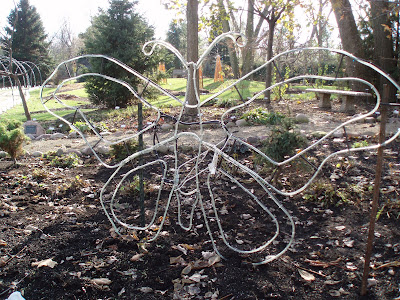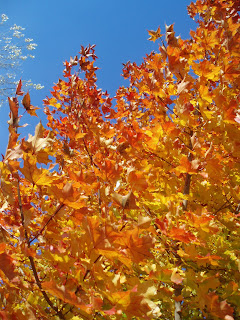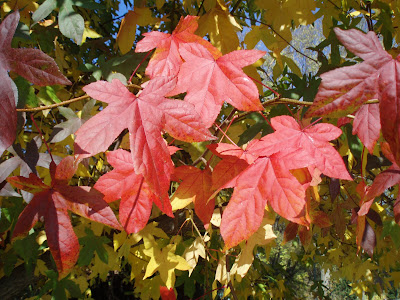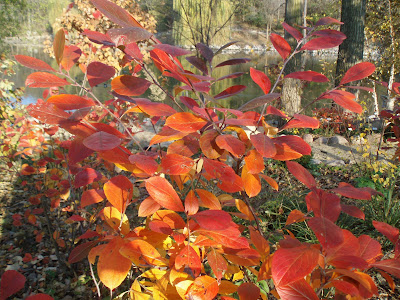
Nice shot of the Russian cypress (
Microbiota decussata) above. This plant can tolerate part shade and will get 12" tall and continue to spread. Originally touted for shade, it prefers some sunlight and requires perfect drainage. Our best specimens are in tough soils, part shade and perfect drainage. It will die quickly in damp areas. This time of year, it also turns a nice bronzy/plum color.
It fluctuated between a light drizzle, heavy drizzle, steady rain and mist today. It never really didn't rain and it never was a downpour. For those of us that went outside (Marv, Terry, Rick, Tony and Jerry), we were all saturated pretty quickly. I managed to run cords most of the day while Marv and Terry set up displays and decorated with lights. Rick and Tony hauled debris, graveled a path and did various odds and ends. Jerry continues to prune and cut back shrubs. Larry went home sick and Marianne was the smart one and stayed inside to work on repairing lights and prepping displays. We're making lots of progress although we still have gardening to accomplish. Rick and Tony will finish next week with the remainder of the garden staff departing the week following (and returning in April 2009).
See below for one of many ways to kill a tree. I can't imagine the roots are pretty happy under all of that asphalt. Consider mulching your tree with 3-4" of woodchips or shredded bark this fall. Taper the mulch away from the base of the tree and understand you'll have to add (topdress) this mulch layer with 1" of fresh stuff every year. Studies have shown that properly mulched trees grow significantly faster than their counterparts growing directly out of turf (competition). Winter is a good time to examine your trees and shrubs for architectural pruning and shaping although know your plant as many prefer to be pruned after flowering (lilacs, etc.).
 Consider the value of ornamental berries in the landscape as you examine your landscape. Ornamental berries can offer colorful interest and may also have significant wildlife value. See the article below.
Consider the value of ornamental berries in the landscape as you examine your landscape. Ornamental berries can offer colorful interest and may also have significant wildlife value. See the article below.
As you enjoy wonderful foods during the cold holiday months of November, December and January, look out in your landscape and realize that wildlife is also looking for food; and perhaps having some difficulty. Many birds and mammals will forage for food through the coldest months of the year. The severity of the winter coupled with limited food supplies can be the difference between life and death for our neighborhood wildlife. Wildlife-friendly gardens should provide food for wildlife through the toughest winter months. While bird feeders, bird houses, nesting boxes and heated bird baths are all helpful, try planting native trees and shrubs that have persistent berries. These food sources will become vital to wildlife in our coldest months.
Landscapes that are friendly to wildlife will contain elements that provide good nesting sites, winter shelter, places to hide from predators and natural food supplies that last throughout the year. Trees and shrubs with winter fruit are those whose fruits remain attached to the plants long after they become ripe in the fall. Many of these berries are not palatable until they have frozen and thawed many times. The National Wildlife Federation has dubbed these plants the “spinach plants” for wildlife. This indicates that while they may be the last food selected by wildlife due to this “transformation of palatability”, their nutrient value at a tough time is vital. It is important to note that some birds never eat seeds and these berries become very important for many resident bird species in late winter and early spring. Small mammals will also utilize these berries as well as available nuts from trees such as oaks, hickories, buckeyes, chestnuts, butternuts, walnuts and hazels. Long-lasting berries can be the life saver for wildlife during tough winters.
There are many plants native to North America that will provide winter berries for our wildlife and also be ornamental throughout the year. Utilize native plants whenever possible if your goal is to attract wildlife. It is interesting to note that native plants will attract forty times more wildlife than non-native plants. Something interesting to note is that while some non-native trees and shrubs do provide berries for wildlife, they are horribly invasive as the seeds are distributed throughout our native ecosystems. Some examples include European Buckthorn, Japanese Barberry, Tatarian Honeysuckle and Russian Olive to name a few. See the accompanying chart for twenty-five great native plants for persistent winter berries. When incorporating these trees and shrubs into your landscape, strive for a variety of plant heights and plant densities. Berries should be provided at all levels and can be done so by utilizing both trees and shrubs. Diverse plantings will be more attractive to a broader range of wildlife.
As you enjoy the winter landscape, notice plants around your neighborhood and parks that are providing berries for wildlife. These fruits can also be quite ornamental and improved varieties of these native species, while still providing wildlife benefits, can easily be incorporated into both formal and informal landscapes. Contact the National Wildlife Federation (1-800-822-9919) for more information on wildlife-friendly landscaping. Including native trees and shrubs that provide essential winter berries will help wildlife through our Wisconsin winters.
 This St. John's wort (Hypericum calycinum 'Brigadoon') was a real eyecatcher today with it's golden/orange coloration and thanks to a late leaf drop, this subshrub (root hardy hopefully) really glows in our woodland walk. We planted 50 of these and I hope they continue to mature and offer great color (golden thru the summer). They are hardy to zone 5 and do prefer full sun but we'll see how they do. Speaking of do (as in doo-doo), the deer are starting to forage in the gardens and we're now erecting posts and will protect their favorite munchies this winter (arborvitae and small pines). See picture below for one of many of their "calling cards". Ugh.
This St. John's wort (Hypericum calycinum 'Brigadoon') was a real eyecatcher today with it's golden/orange coloration and thanks to a late leaf drop, this subshrub (root hardy hopefully) really glows in our woodland walk. We planted 50 of these and I hope they continue to mature and offer great color (golden thru the summer). They are hardy to zone 5 and do prefer full sun but we'll see how they do. Speaking of do (as in doo-doo), the deer are starting to forage in the gardens and we're now erecting posts and will protect their favorite munchies this winter (arborvitae and small pines). See picture below for one of many of their "calling cards". Ugh.



.jpg)


 The landscape is now becoming starker as winter digs in and snow starts to accumulate. Our gardens are biding their time until active growth can resume with warmer soil temperatures and spring rains. Now is a great time to enjoy conifers in the garden or locate those spots that can use a structural element, focal point and/or a “splash” of color. Conifers are considered the “bones” of the garden and should be in place before other elements are added. They are the perfect “foil” for perennials and annuals during the summer and they take center stage during the winter months.
The landscape is now becoming starker as winter digs in and snow starts to accumulate. Our gardens are biding their time until active growth can resume with warmer soil temperatures and spring rains. Now is a great time to enjoy conifers in the garden or locate those spots that can use a structural element, focal point and/or a “splash” of color. Conifers are considered the “bones” of the garden and should be in place before other elements are added. They are the perfect “foil” for perennials and annuals during the summer and they take center stage during the winter months.
 This morning was our last work day of the year. Marianne and Janice lead a crew of about 10 volunteers out in the gardens. The task was putting lights on all the white pine trees that we cut on Monday, set up on stakes and will use as temporary decorations. The weather was brisk and windy but at least not rainy. Thanks to the ladies for their help and thanks to Luis, Terri, Kay, Maggie, Lynn, Steve, Jody, Marcus, Chris and a young fellow from UW-Whitewater. Larry also was out putting up lights and I ran more cords. There is light at the end of the tunnel.
This morning was our last work day of the year. Marianne and Janice lead a crew of about 10 volunteers out in the gardens. The task was putting lights on all the white pine trees that we cut on Monday, set up on stakes and will use as temporary decorations. The weather was brisk and windy but at least not rainy. Thanks to the ladies for their help and thanks to Luis, Terri, Kay, Maggie, Lynn, Steve, Jody, Marcus, Chris and a young fellow from UW-Whitewater. Larry also was out putting up lights and I ran more cords. There is light at the end of the tunnel.







 Consider the value of ornamental berries in the landscape as you examine your landscape. Ornamental berries can offer colorful interest and may also have significant wildlife value. See the article below.
Consider the value of ornamental berries in the landscape as you examine your landscape. Ornamental berries can offer colorful interest and may also have significant wildlife value. See the article below.
 The moisture didn't stop Marv & Marianne (volunteering) from helping with the lights show while Janice worked with Heidi and Barb out in the garden as we finish the last of our bulb planting and clean-up. Larry and I worked on cords while Rick and Tony cleaned up debris and helped with show set-up as well. Bill and Dr. Gredler were also around to help in the gardens. I small, damp crew but we accomplished a lot on what I thought would be a "rain/snow out"! The ground isn't frozen yet so head out and get some discounted bulbs this weekend and get them in the ground. A nice way to incorporate multiple types of bulbs in the same hole is called "bulb lasagne". This is a great way to segway color, particularly in a small space. See the article below for some ideas.
The moisture didn't stop Marv & Marianne (volunteering) from helping with the lights show while Janice worked with Heidi and Barb out in the garden as we finish the last of our bulb planting and clean-up. Larry and I worked on cords while Rick and Tony cleaned up debris and helped with show set-up as well. Bill and Dr. Gredler were also around to help in the gardens. I small, damp crew but we accomplished a lot on what I thought would be a "rain/snow out"! The ground isn't frozen yet so head out and get some discounted bulbs this weekend and get them in the ground. A nice way to incorporate multiple types of bulbs in the same hole is called "bulb lasagne". This is a great way to segway color, particularly in a small space. See the article below for some ideas.



 The view of our November landscapes encompasses the transition from the fading blooms of late summer and vivid fall colors to a landscape of faded greens, tans and browns. While color may lack in our gardens this time of year, texture and form come to the forefront. Ornamental grasses in the garden, while contributing as role players through the growing season, become very important in anchoring our compositions, providing visual interest and perhaps helping our native wildlife as well. There are many hardy, ornamental grasses to choose from but why not consider some tried and true native grasses that will accent and improve your landscape?
The view of our November landscapes encompasses the transition from the fading blooms of late summer and vivid fall colors to a landscape of faded greens, tans and browns. While color may lack in our gardens this time of year, texture and form come to the forefront. Ornamental grasses in the garden, while contributing as role players through the growing season, become very important in anchoring our compositions, providing visual interest and perhaps helping our native wildlife as well. There are many hardy, ornamental grasses to choose from but why not consider some tried and true native grasses that will accent and improve your landscape? 
















